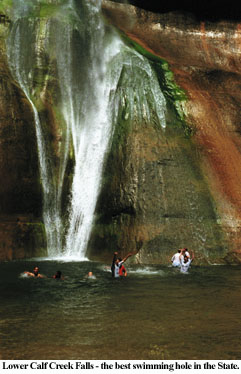|
|
Discover Beautiful Calf Creek Falls
 By
Golden Webb
By
Golden Webb
It is places like Calf Creek that remind you that God is still creating the earth. White sandstone, his marble; flowing water, his chisel, he has created and is creating fine art in the box canyon of this beautiful spring-fed stream.
Day after day the sweet water boils out of the rock above the Upper Falls and begins its tortuous run to the Escalante. Along the way it sculpts and polishes the bedrock, carving the sandstone grain by grain, relentless in its flow. Thus the canyon is in a constant state of flux, changing, albeit invisibly, right before your very eyes. That's part of the magic of this country. Like a beach pounded by individual and unique ocean waves, its beauty and function are constant, yet its face is ever changing.
Calf Creek is located a few miles southwest of Boulder town and is so named because pioneer stockmen used the drainage as a natural stock pen where calves were weaned. It forms two boxes, an upper and a lower, divided by the silvery braids of Lower Calf Creek Falls.
The hike to the Lower Falls is one of the most beautiful, and popular, in Southern Utah. Starting at a BLM campground and picnic area, the sandy, self-guided nature trail follows the stream past petroglyphs and Indian ruins to the waterfall and its deep-blue pool. Surrounding the pool are vibrant hanging gardens and luxurious growths of moss, ferns, watercress, columbine, sedges, and monkeyflower.
 Less
well known yet equally beautiful is the Upper Falls. It is a smaller version
of the Lower Falls, with an 86-foot ribbon of water falling into a shimmering
plunge-pool. Fluorescent green moss carpets the wall behind the falls, and
hanging gardens thrive in the misty air. Above the falls are deep water-pockets
that make for an exhilarating swim, while the plunge-pool of the falls itself
is cold and clean, the perfect place to wash away accumulated sorrows.
Less
well known yet equally beautiful is the Upper Falls. It is a smaller version
of the Lower Falls, with an 86-foot ribbon of water falling into a shimmering
plunge-pool. Fluorescent green moss carpets the wall behind the falls, and
hanging gardens thrive in the misty air. Above the falls are deep water-pockets
that make for an exhilarating swim, while the plunge-pool of the falls itself
is cold and clean, the perfect place to wash away accumulated sorrows.
This is pure mountain water, percolating down from the Aquarius Plateau to emerge from the slickrock. The Shoshone Indians of the Wind River Range believed that when a good warrior died he fell into a stream of sparkling water that carried him into a land of eternal bliss. To dive into one of the pools of Calf Creek in the middle of a hot desert day is to enter heaven.
The hike to the Lower Falls is exposed to the sun much of the way, and the climb out of the basin from the Upper Falls is a bit steep, but both of these are great excursions for families, or for those seeking an easy half-day hike.
For the more adventurous, the hike along the stream between the two is a delight. Three miles one way, the trail stays mostly in the water and follows the stream's contours between walls of white, pink, and red sandstone. Along the way are shady groves of cottonwood, towering ponderosa pine, luxurious growths of watercress, seeps and springs and hanging gardens, and hundreds of darting fish, silver-gold trout with speckled bodies.
The final approach before the lower falls is exciting. The walls pull together and the stream runs out over a sandstone staircase that is dotted with carved out water-pockets. Small cascades pour into these water-holes, creating invigorating ice-cold jacuzzis. A final small cascade, a deep pool sometimes full of rippled sand, sometimes dark and fathomless, and then the stream rounds a curve and launches into space. Cautious footsteps bring you to a beautiful and unique view in a beautiful and unique canyon.
How to get there
Drive along Highway 12 between Boulder and Escalante. The trailhead to Lower Calf Creek Falls starts at the BLM campground just north of the bridge that crosses the Escalante River.
The trailhead to Upper Calf Creek Falls is located on the Hogsback, the sandstone ridge that separates Calf Creek and Boulder Creek/Dry Hollow. A dirt road branches off to the west between mileposts 81 and 82, winding through the pinyon pine for a few hundred yards to a sandy clearing near the rim. A trail register is found beneath a large pinyon pine with a V-shaped canopy. The trail drops down into a circular basin that drains into the stream. Basalt boulders, washed down from the Aquarius Plateau, have been cleared to make a path over the snow-white sandstone.
